University of South Wales: PL2D100 Critical Review of Bramel's Study
VerifiedAdded on 2023/01/19
|7
|2293
|51
Report
AI Summary
This report provides a critical review of Dana Bramel's 1963 study on defensive projection, examining the hypothesis that individuals attribute undesirable traits to members of their own social group rather than out-group members when experiencing dissonance. The study involved college students who were informed about their homosexual motivations and then asked to rate the homosexuality of a speaker. The report analyzes the experimental design, methodology, and results, including the use of a galvanic skin response apparatus. The review also considers the ethical implications of the study, particularly concerning deception and the potential for psychological harm to the participants. The study's strengths and weaknesses are assessed, and its contribution to the understanding of projection and social psychology is evaluated. Additionally, this review incorporates the ethical guidelines as published by the British Psychological Society.
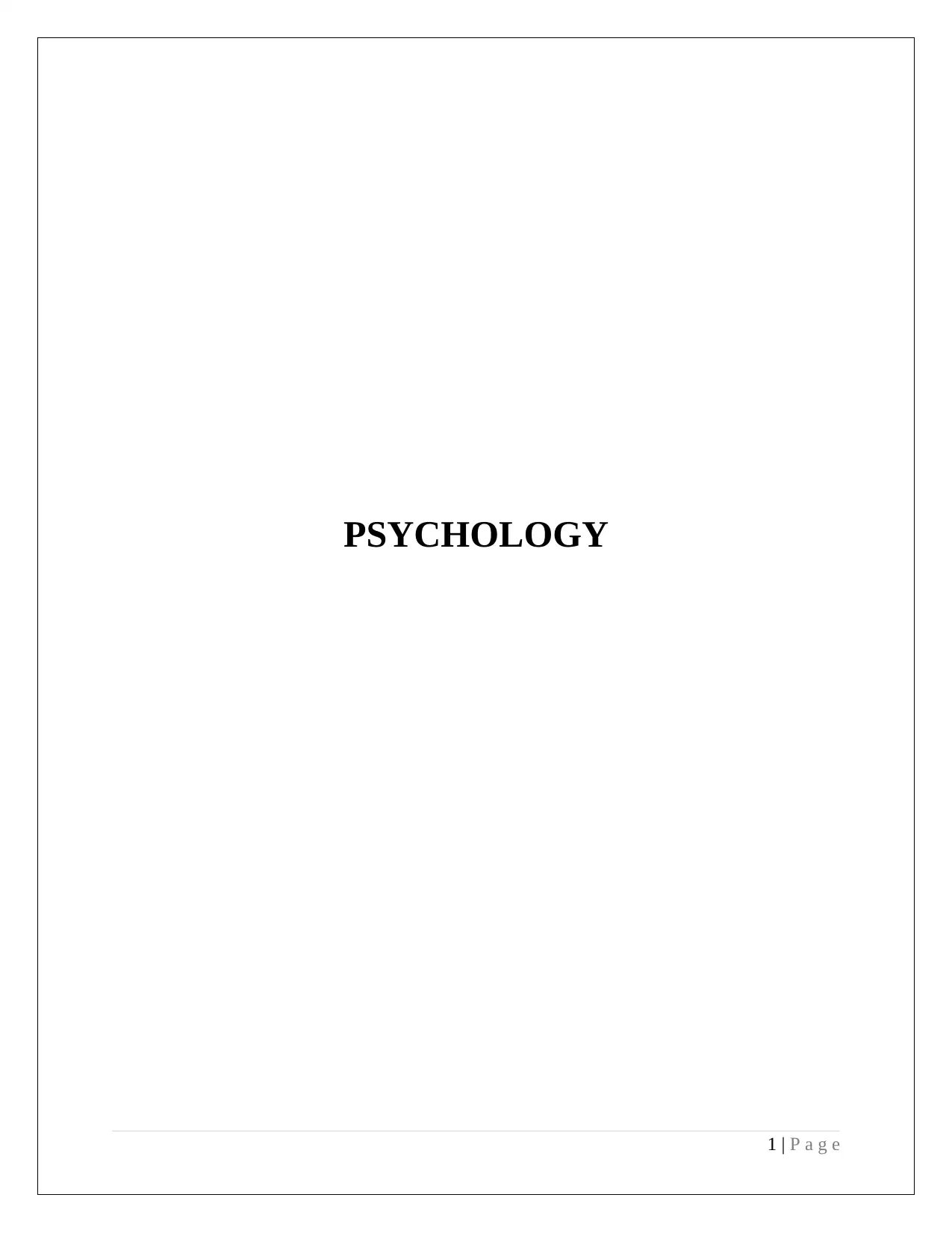
PSYCHOLOGY
1 | P a g e
1 | P a g e
Paraphrase This Document
Need a fresh take? Get an instant paraphrase of this document with our AI Paraphraser
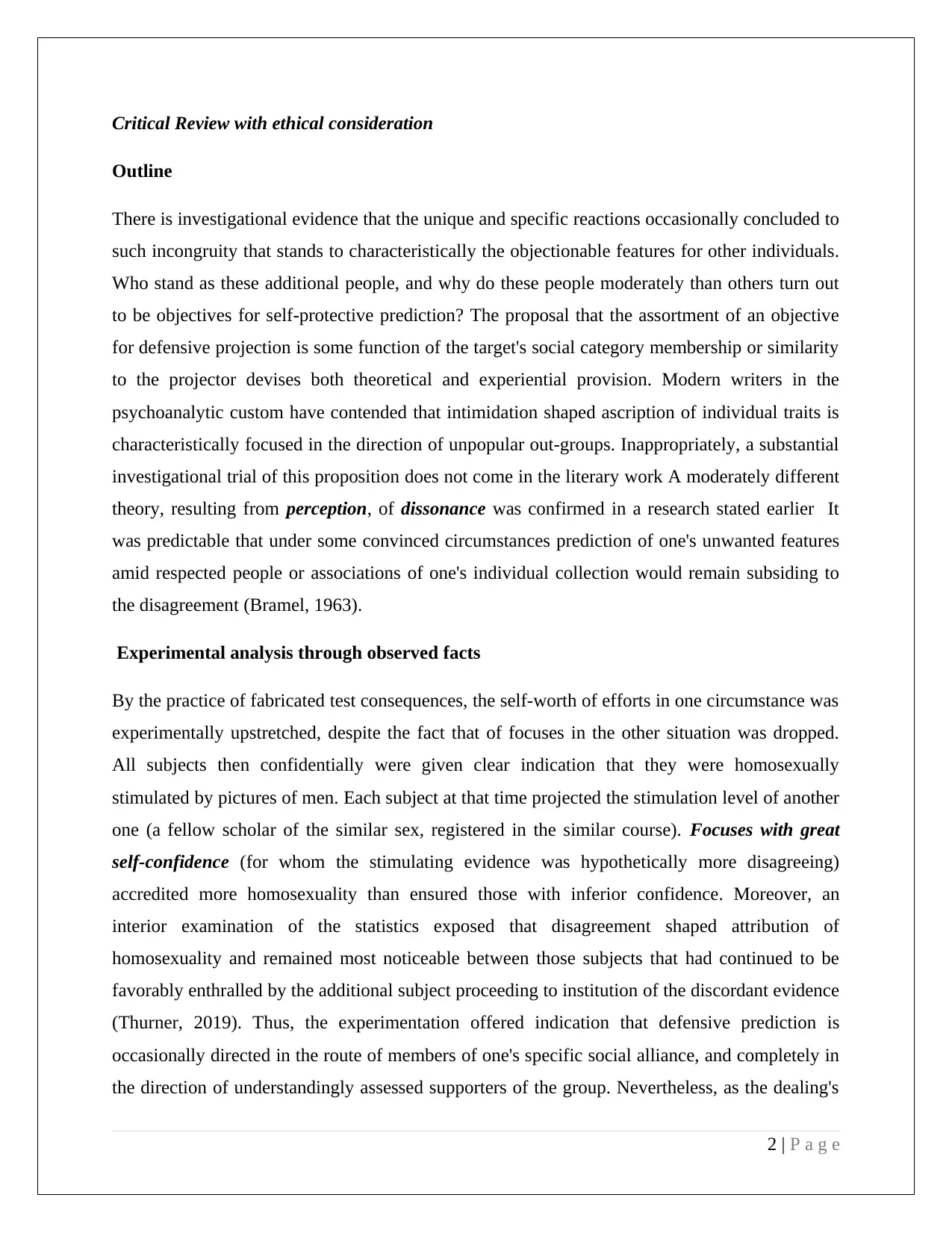
Critical Review with ethical consideration
Outline
There is investigational evidence that the unique and specific reactions occasionally concluded to
such incongruity that stands to characteristically the objectionable features for other individuals.
Who stand as these additional people, and why do these people moderately than others turn out
to be objectives for self-protective prediction? The proposal that the assortment of an objective
for defensive projection is some function of the target's social category membership or similarity
to the projector devises both theoretical and experiential provision. Modern writers in the
psychoanalytic custom have contended that intimidation shaped ascription of individual traits is
characteristically focused in the direction of unpopular out-groups. Inappropriately, a substantial
investigational trial of this proposition does not come in the literary work A moderately different
theory, resulting from perception, of dissonance was confirmed in a research stated earlier It
was predictable that under some convinced circumstances prediction of one's unwanted features
amid respected people or associations of one's individual collection would remain subsiding to
the disagreement (Bramel, 1963).
Experimental analysis through observed facts
By the practice of fabricated test consequences, the self-worth of efforts in one circumstance was
experimentally upstretched, despite the fact that of focuses in the other situation was dropped.
All subjects then confidentially were given clear indication that they were homosexually
stimulated by pictures of men. Each subject at that time projected the stimulation level of another
one (a fellow scholar of the similar sex, registered in the similar course). Focuses with great
self-confidence (for whom the stimulating evidence was hypothetically more disagreeing)
accredited more homosexuality than ensured those with inferior confidence. Moreover, an
interior examination of the statistics exposed that disagreement shaped attribution of
homosexuality and remained most noticeable between those subjects that had continued to be
favorably enthralled by the additional subject proceeding to institution of the discordant evidence
(Thurner, 2019). Thus, the experimentation offered indication that defensive prediction is
occasionally directed in the route of members of one's specific social alliance, and completely in
the direction of understandingly assessed supporters of the group. Nevertheless, as the dealing's
2 | P a g e
Outline
There is investigational evidence that the unique and specific reactions occasionally concluded to
such incongruity that stands to characteristically the objectionable features for other individuals.
Who stand as these additional people, and why do these people moderately than others turn out
to be objectives for self-protective prediction? The proposal that the assortment of an objective
for defensive projection is some function of the target's social category membership or similarity
to the projector devises both theoretical and experiential provision. Modern writers in the
psychoanalytic custom have contended that intimidation shaped ascription of individual traits is
characteristically focused in the direction of unpopular out-groups. Inappropriately, a substantial
investigational trial of this proposition does not come in the literary work A moderately different
theory, resulting from perception, of dissonance was confirmed in a research stated earlier It
was predictable that under some convinced circumstances prediction of one's unwanted features
amid respected people or associations of one's individual collection would remain subsiding to
the disagreement (Bramel, 1963).
Experimental analysis through observed facts
By the practice of fabricated test consequences, the self-worth of efforts in one circumstance was
experimentally upstretched, despite the fact that of focuses in the other situation was dropped.
All subjects then confidentially were given clear indication that they were homosexually
stimulated by pictures of men. Each subject at that time projected the stimulation level of another
one (a fellow scholar of the similar sex, registered in the similar course). Focuses with great
self-confidence (for whom the stimulating evidence was hypothetically more disagreeing)
accredited more homosexuality than ensured those with inferior confidence. Moreover, an
interior examination of the statistics exposed that disagreement shaped attribution of
homosexuality and remained most noticeable between those subjects that had continued to be
favorably enthralled by the additional subject proceeding to institution of the discordant evidence
(Thurner, 2019). Thus, the experimentation offered indication that defensive prediction is
occasionally directed in the route of members of one's specific social alliance, and completely in
the direction of understandingly assessed supporters of the group. Nevertheless, as the dealing's
2 | P a g e
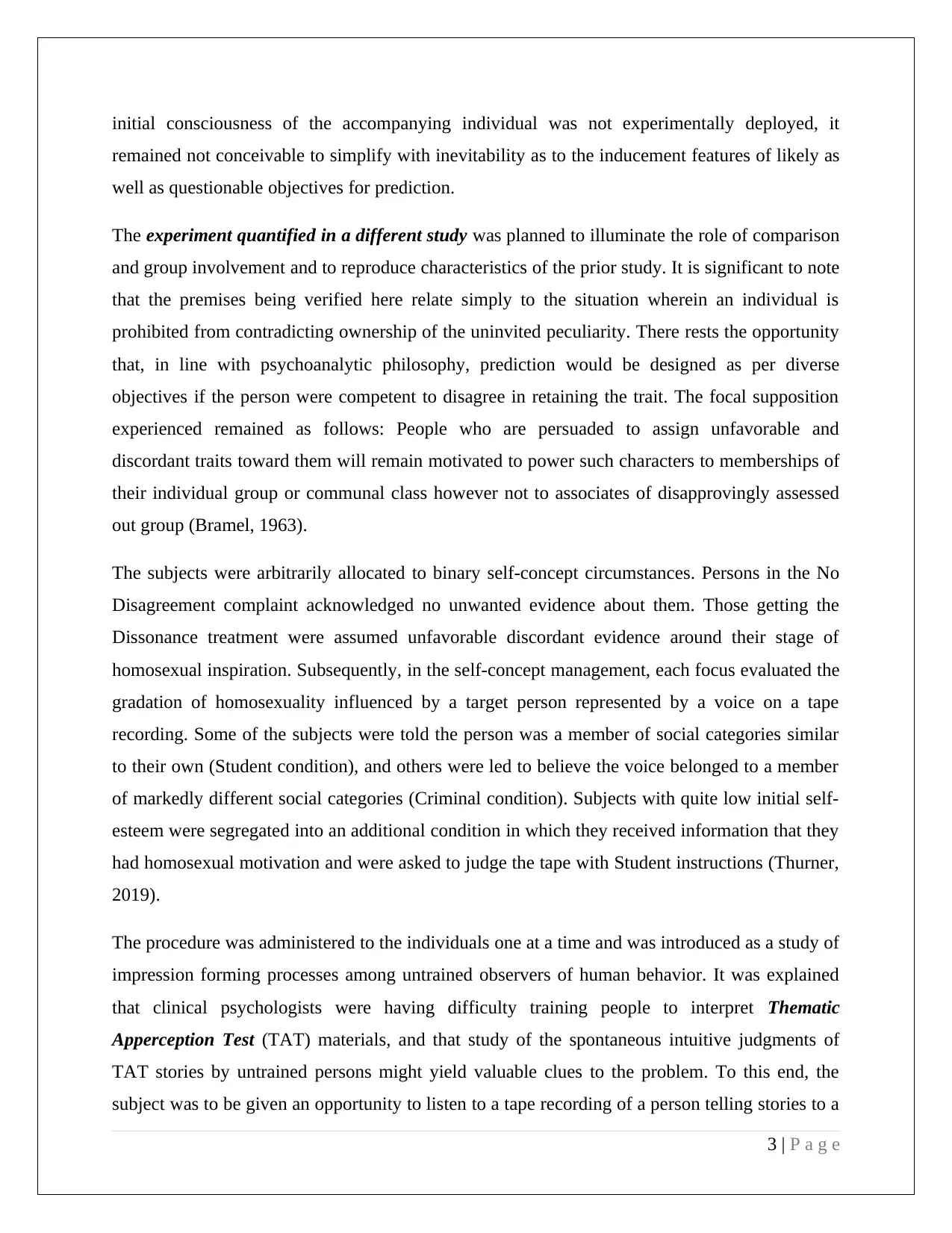
initial consciousness of the accompanying individual was not experimentally deployed, it
remained not conceivable to simplify with inevitability as to the inducement features of likely as
well as questionable objectives for prediction.
The experiment quantified in a different study was planned to illuminate the role of comparison
and group involvement and to reproduce characteristics of the prior study. It is significant to note
that the premises being verified here relate simply to the situation wherein an individual is
prohibited from contradicting ownership of the uninvited peculiarity. There rests the opportunity
that, in line with psychoanalytic philosophy, prediction would be designed as per diverse
objectives if the person were competent to disagree in retaining the trait. The focal supposition
experienced remained as follows: People who are persuaded to assign unfavorable and
discordant traits toward them will remain motivated to power such characters to memberships of
their individual group or communal class however not to associates of disapprovingly assessed
out group (Bramel, 1963).
The subjects were arbitrarily allocated to binary self-concept circumstances. Persons in the No
Disagreement complaint acknowledged no unwanted evidence about them. Those getting the
Dissonance treatment were assumed unfavorable discordant evidence around their stage of
homosexual inspiration. Subsequently, in the self-concept management, each focus evaluated the
gradation of homosexuality influenced by a target person represented by a voice on a tape
recording. Some of the subjects were told the person was a member of social categories similar
to their own (Student condition), and others were led to believe the voice belonged to a member
of markedly different social categories (Criminal condition). Subjects with quite low initial self-
esteem were segregated into an additional condition in which they received information that they
had homosexual motivation and were asked to judge the tape with Student instructions (Thurner,
2019).
The procedure was administered to the individuals one at a time and was introduced as a study of
impression forming processes among untrained observers of human behavior. It was explained
that clinical psychologists were having difficulty training people to interpret Thematic
Apperception Test (TAT) materials, and that study of the spontaneous intuitive judgments of
TAT stories by untrained persons might yield valuable clues to the problem. To this end, the
subject was to be given an opportunity to listen to a tape recording of a person telling stories to a
3 | P a g e
remained not conceivable to simplify with inevitability as to the inducement features of likely as
well as questionable objectives for prediction.
The experiment quantified in a different study was planned to illuminate the role of comparison
and group involvement and to reproduce characteristics of the prior study. It is significant to note
that the premises being verified here relate simply to the situation wherein an individual is
prohibited from contradicting ownership of the uninvited peculiarity. There rests the opportunity
that, in line with psychoanalytic philosophy, prediction would be designed as per diverse
objectives if the person were competent to disagree in retaining the trait. The focal supposition
experienced remained as follows: People who are persuaded to assign unfavorable and
discordant traits toward them will remain motivated to power such characters to memberships of
their individual group or communal class however not to associates of disapprovingly assessed
out group (Bramel, 1963).
The subjects were arbitrarily allocated to binary self-concept circumstances. Persons in the No
Disagreement complaint acknowledged no unwanted evidence about them. Those getting the
Dissonance treatment were assumed unfavorable discordant evidence around their stage of
homosexual inspiration. Subsequently, in the self-concept management, each focus evaluated the
gradation of homosexuality influenced by a target person represented by a voice on a tape
recording. Some of the subjects were told the person was a member of social categories similar
to their own (Student condition), and others were led to believe the voice belonged to a member
of markedly different social categories (Criminal condition). Subjects with quite low initial self-
esteem were segregated into an additional condition in which they received information that they
had homosexual motivation and were asked to judge the tape with Student instructions (Thurner,
2019).
The procedure was administered to the individuals one at a time and was introduced as a study of
impression forming processes among untrained observers of human behavior. It was explained
that clinical psychologists were having difficulty training people to interpret Thematic
Apperception Test (TAT) materials, and that study of the spontaneous intuitive judgments of
TAT stories by untrained persons might yield valuable clues to the problem. To this end, the
subject was to be given an opportunity to listen to a tape recording of a person telling stories to a
3 | P a g e
⊘ This is a preview!⊘
Do you want full access?
Subscribe today to unlock all pages.

Trusted by 1+ million students worldwide
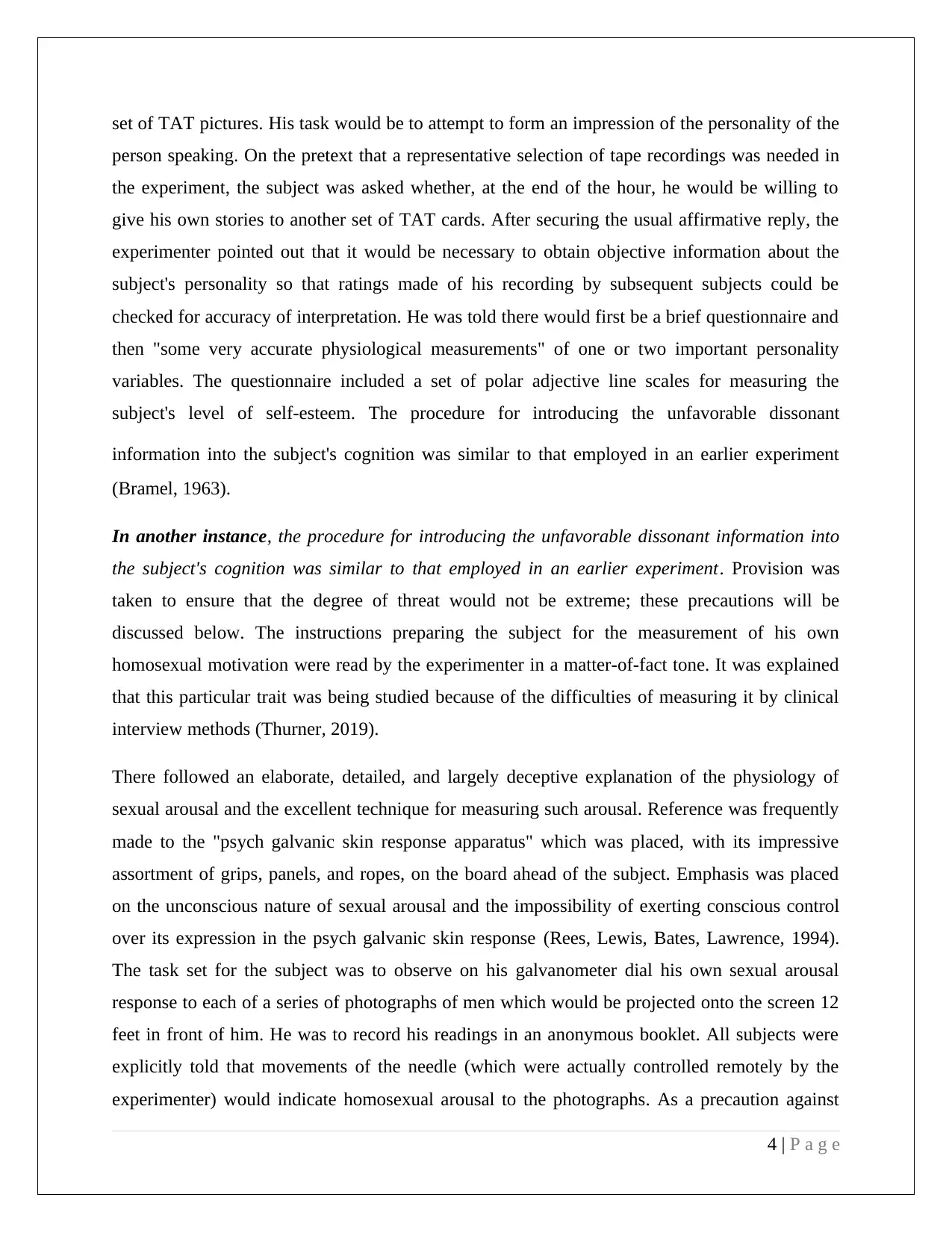
set of TAT pictures. His task would be to attempt to form an impression of the personality of the
person speaking. On the pretext that a representative selection of tape recordings was needed in
the experiment, the subject was asked whether, at the end of the hour, he would be willing to
give his own stories to another set of TAT cards. After securing the usual affirmative reply, the
experimenter pointed out that it would be necessary to obtain objective information about the
subject's personality so that ratings made of his recording by subsequent subjects could be
checked for accuracy of interpretation. He was told there would first be a brief questionnaire and
then "some very accurate physiological measurements" of one or two important personality
variables. The questionnaire included a set of polar adjective line scales for measuring the
subject's level of self-esteem. The procedure for introducing the unfavorable dissonant
information into the subject's cognition was similar to that employed in an earlier experiment
(Bramel, 1963).
In another instance, the procedure for introducing the unfavorable dissonant information into
the subject's cognition was similar to that employed in an earlier experiment. Provision was
taken to ensure that the degree of threat would not be extreme; these precautions will be
discussed below. The instructions preparing the subject for the measurement of his own
homosexual motivation were read by the experimenter in a matter-of-fact tone. It was explained
that this particular trait was being studied because of the difficulties of measuring it by clinical
interview methods (Thurner, 2019).
There followed an elaborate, detailed, and largely deceptive explanation of the physiology of
sexual arousal and the excellent technique for measuring such arousal. Reference was frequently
made to the "psych galvanic skin response apparatus" which was placed, with its impressive
assortment of grips, panels, and ropes, on the board ahead of the subject. Emphasis was placed
on the unconscious nature of sexual arousal and the impossibility of exerting conscious control
over its expression in the psych galvanic skin response (Rees, Lewis, Bates, Lawrence, 1994).
The task set for the subject was to observe on his galvanometer dial his own sexual arousal
response to each of a series of photographs of men which would be projected onto the screen 12
feet in front of him. He was to record his readings in an anonymous booklet. All subjects were
explicitly told that movements of the needle (which were actually controlled remotely by the
experimenter) would indicate homosexual arousal to the photographs. As a precaution against
4 | P a g e
person speaking. On the pretext that a representative selection of tape recordings was needed in
the experiment, the subject was asked whether, at the end of the hour, he would be willing to
give his own stories to another set of TAT cards. After securing the usual affirmative reply, the
experimenter pointed out that it would be necessary to obtain objective information about the
subject's personality so that ratings made of his recording by subsequent subjects could be
checked for accuracy of interpretation. He was told there would first be a brief questionnaire and
then "some very accurate physiological measurements" of one or two important personality
variables. The questionnaire included a set of polar adjective line scales for measuring the
subject's level of self-esteem. The procedure for introducing the unfavorable dissonant
information into the subject's cognition was similar to that employed in an earlier experiment
(Bramel, 1963).
In another instance, the procedure for introducing the unfavorable dissonant information into
the subject's cognition was similar to that employed in an earlier experiment. Provision was
taken to ensure that the degree of threat would not be extreme; these precautions will be
discussed below. The instructions preparing the subject for the measurement of his own
homosexual motivation were read by the experimenter in a matter-of-fact tone. It was explained
that this particular trait was being studied because of the difficulties of measuring it by clinical
interview methods (Thurner, 2019).
There followed an elaborate, detailed, and largely deceptive explanation of the physiology of
sexual arousal and the excellent technique for measuring such arousal. Reference was frequently
made to the "psych galvanic skin response apparatus" which was placed, with its impressive
assortment of grips, panels, and ropes, on the board ahead of the subject. Emphasis was placed
on the unconscious nature of sexual arousal and the impossibility of exerting conscious control
over its expression in the psych galvanic skin response (Rees, Lewis, Bates, Lawrence, 1994).
The task set for the subject was to observe on his galvanometer dial his own sexual arousal
response to each of a series of photographs of men which would be projected onto the screen 12
feet in front of him. He was to record his readings in an anonymous booklet. All subjects were
explicitly told that movements of the needle (which were actually controlled remotely by the
experimenter) would indicate homosexual arousal to the photographs. As a precaution against
4 | P a g e
Paraphrase This Document
Need a fresh take? Get an instant paraphrase of this document with our AI Paraphraser
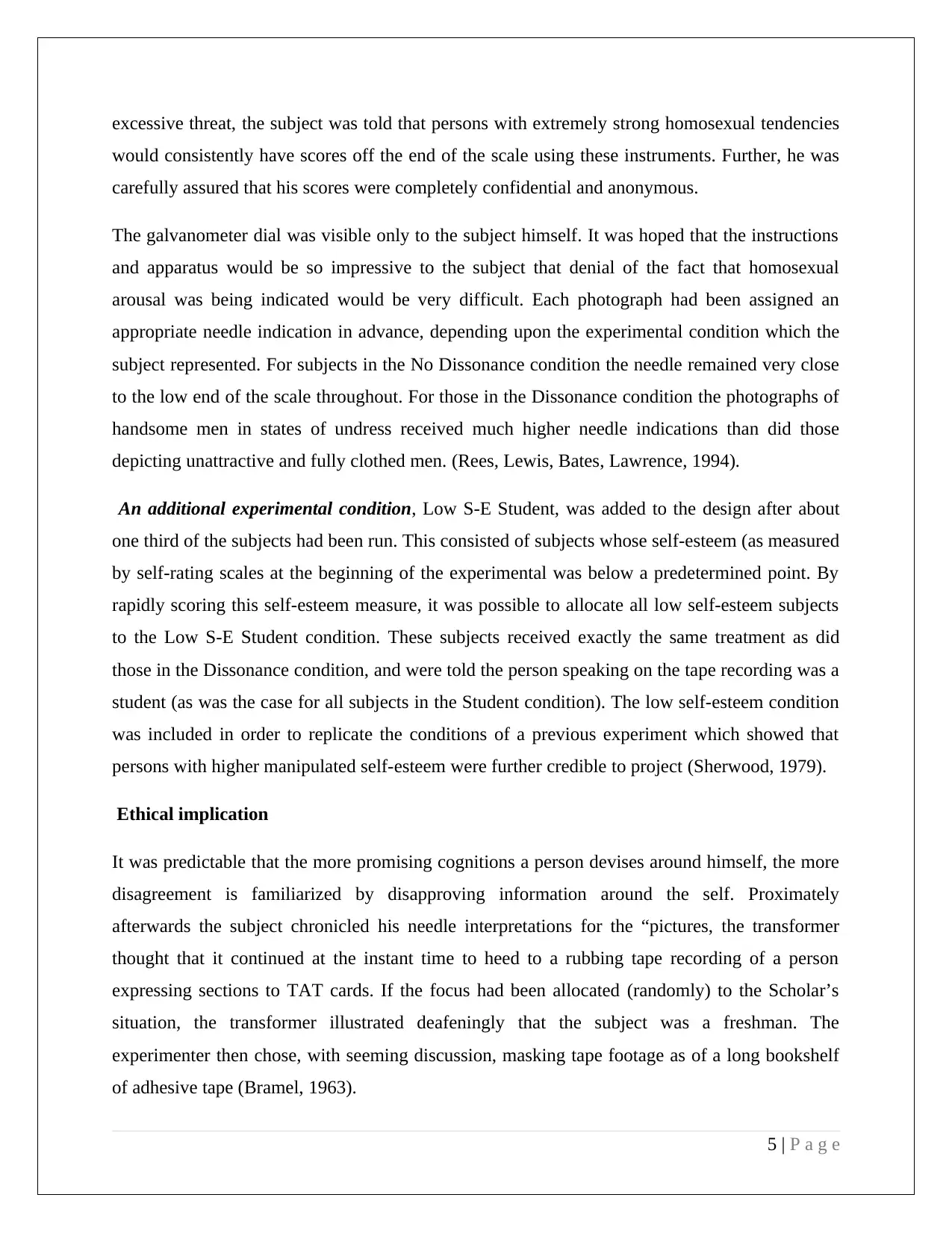
excessive threat, the subject was told that persons with extremely strong homosexual tendencies
would consistently have scores off the end of the scale using these instruments. Further, he was
carefully assured that his scores were completely confidential and anonymous.
The galvanometer dial was visible only to the subject himself. It was hoped that the instructions
and apparatus would be so impressive to the subject that denial of the fact that homosexual
arousal was being indicated would be very difficult. Each photograph had been assigned an
appropriate needle indication in advance, depending upon the experimental condition which the
subject represented. For subjects in the No Dissonance condition the needle remained very close
to the low end of the scale throughout. For those in the Dissonance condition the photographs of
handsome men in states of undress received much higher needle indications than did those
depicting unattractive and fully clothed men. (Rees, Lewis, Bates, Lawrence, 1994).
An additional experimental condition, Low S-E Student, was added to the design after about
one third of the subjects had been run. This consisted of subjects whose self-esteem (as measured
by self-rating scales at the beginning of the experimental was below a predetermined point. By
rapidly scoring this self-esteem measure, it was possible to allocate all low self-esteem subjects
to the Low S-E Student condition. These subjects received exactly the same treatment as did
those in the Dissonance condition, and were told the person speaking on the tape recording was a
student (as was the case for all subjects in the Student condition). The low self-esteem condition
was included in order to replicate the conditions of a previous experiment which showed that
persons with higher manipulated self-esteem were further credible to project (Sherwood, 1979).
Ethical implication
It was predictable that the more promising cognitions a person devises around himself, the more
disagreement is familiarized by disapproving information around the self. Proximately
afterwards the subject chronicled his needle interpretations for the “pictures, the transformer
thought that it continued at the instant time to heed to a rubbing tape recording of a person
expressing sections to TAT cards. If the focus had been allocated (randomly) to the Scholar’s
situation, the transformer illustrated deafeningly that the subject was a freshman. The
experimenter then chose, with seeming discussion, masking tape footage as of a long bookshelf
of adhesive tape (Bramel, 1963).
5 | P a g e
would consistently have scores off the end of the scale using these instruments. Further, he was
carefully assured that his scores were completely confidential and anonymous.
The galvanometer dial was visible only to the subject himself. It was hoped that the instructions
and apparatus would be so impressive to the subject that denial of the fact that homosexual
arousal was being indicated would be very difficult. Each photograph had been assigned an
appropriate needle indication in advance, depending upon the experimental condition which the
subject represented. For subjects in the No Dissonance condition the needle remained very close
to the low end of the scale throughout. For those in the Dissonance condition the photographs of
handsome men in states of undress received much higher needle indications than did those
depicting unattractive and fully clothed men. (Rees, Lewis, Bates, Lawrence, 1994).
An additional experimental condition, Low S-E Student, was added to the design after about
one third of the subjects had been run. This consisted of subjects whose self-esteem (as measured
by self-rating scales at the beginning of the experimental was below a predetermined point. By
rapidly scoring this self-esteem measure, it was possible to allocate all low self-esteem subjects
to the Low S-E Student condition. These subjects received exactly the same treatment as did
those in the Dissonance condition, and were told the person speaking on the tape recording was a
student (as was the case for all subjects in the Student condition). The low self-esteem condition
was included in order to replicate the conditions of a previous experiment which showed that
persons with higher manipulated self-esteem were further credible to project (Sherwood, 1979).
Ethical implication
It was predictable that the more promising cognitions a person devises around himself, the more
disagreement is familiarized by disapproving information around the self. Proximately
afterwards the subject chronicled his needle interpretations for the “pictures, the transformer
thought that it continued at the instant time to heed to a rubbing tape recording of a person
expressing sections to TAT cards. If the focus had been allocated (randomly) to the Scholar’s
situation, the transformer illustrated deafeningly that the subject was a freshman. The
experimenter then chose, with seeming discussion, masking tape footage as of a long bookshelf
of adhesive tape (Bramel, 1963).
5 | P a g e
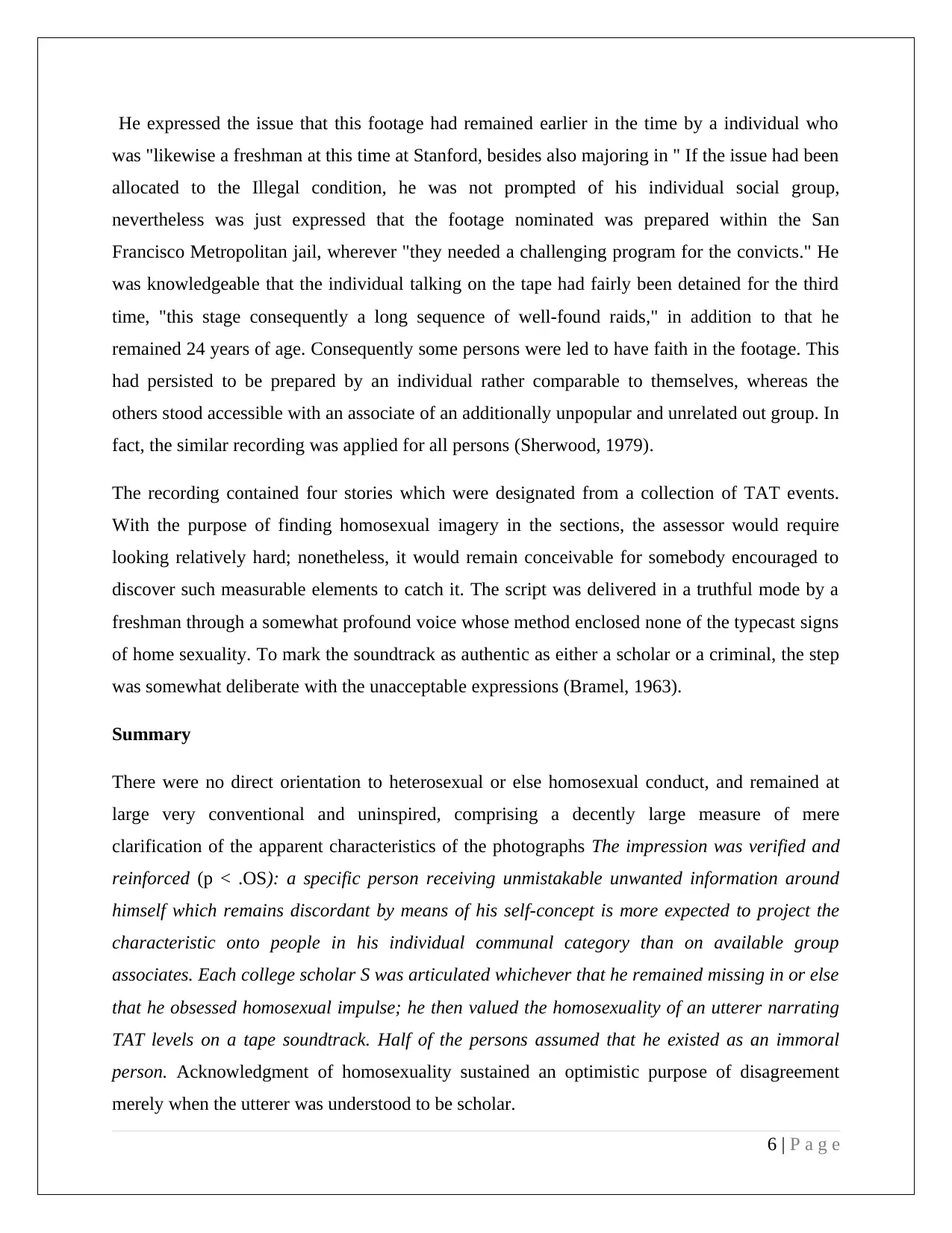
He expressed the issue that this footage had remained earlier in the time by a individual who
was "likewise a freshman at this time at Stanford, besides also majoring in " If the issue had been
allocated to the Illegal condition, he was not prompted of his individual social group,
nevertheless was just expressed that the footage nominated was prepared within the San
Francisco Metropolitan jail, wherever "they needed a challenging program for the convicts." He
was knowledgeable that the individual talking on the tape had fairly been detained for the third
time, "this stage consequently a long sequence of well-found raids," in addition to that he
remained 24 years of age. Consequently some persons were led to have faith in the footage. This
had persisted to be prepared by an individual rather comparable to themselves, whereas the
others stood accessible with an associate of an additionally unpopular and unrelated out group. In
fact, the similar recording was applied for all persons (Sherwood, 1979).
The recording contained four stories which were designated from a collection of TAT events.
With the purpose of finding homosexual imagery in the sections, the assessor would require
looking relatively hard; nonetheless, it would remain conceivable for somebody encouraged to
discover such measurable elements to catch it. The script was delivered in a truthful mode by a
freshman through a somewhat profound voice whose method enclosed none of the typecast signs
of home sexuality. To mark the soundtrack as authentic as either a scholar or a criminal, the step
was somewhat deliberate with the unacceptable expressions (Bramel, 1963).
Summary
There were no direct orientation to heterosexual or else homosexual conduct, and remained at
large very conventional and uninspired, comprising a decently large measure of mere
clarification of the apparent characteristics of the photographs The impression was verified and
reinforced (p < .OS): a specific person receiving unmistakable unwanted information around
himself which remains discordant by means of his self-concept is more expected to project the
characteristic onto people in his individual communal category than on available group
associates. Each college scholar S was articulated whichever that he remained missing in or else
that he obsessed homosexual impulse; he then valued the homosexuality of an utterer narrating
TAT levels on a tape soundtrack. Half of the persons assumed that he existed as an immoral
person. Acknowledgment of homosexuality sustained an optimistic purpose of disagreement
merely when the utterer was understood to be scholar.
6 | P a g e
was "likewise a freshman at this time at Stanford, besides also majoring in " If the issue had been
allocated to the Illegal condition, he was not prompted of his individual social group,
nevertheless was just expressed that the footage nominated was prepared within the San
Francisco Metropolitan jail, wherever "they needed a challenging program for the convicts." He
was knowledgeable that the individual talking on the tape had fairly been detained for the third
time, "this stage consequently a long sequence of well-found raids," in addition to that he
remained 24 years of age. Consequently some persons were led to have faith in the footage. This
had persisted to be prepared by an individual rather comparable to themselves, whereas the
others stood accessible with an associate of an additionally unpopular and unrelated out group. In
fact, the similar recording was applied for all persons (Sherwood, 1979).
The recording contained four stories which were designated from a collection of TAT events.
With the purpose of finding homosexual imagery in the sections, the assessor would require
looking relatively hard; nonetheless, it would remain conceivable for somebody encouraged to
discover such measurable elements to catch it. The script was delivered in a truthful mode by a
freshman through a somewhat profound voice whose method enclosed none of the typecast signs
of home sexuality. To mark the soundtrack as authentic as either a scholar or a criminal, the step
was somewhat deliberate with the unacceptable expressions (Bramel, 1963).
Summary
There were no direct orientation to heterosexual or else homosexual conduct, and remained at
large very conventional and uninspired, comprising a decently large measure of mere
clarification of the apparent characteristics of the photographs The impression was verified and
reinforced (p < .OS): a specific person receiving unmistakable unwanted information around
himself which remains discordant by means of his self-concept is more expected to project the
characteristic onto people in his individual communal category than on available group
associates. Each college scholar S was articulated whichever that he remained missing in or else
that he obsessed homosexual impulse; he then valued the homosexuality of an utterer narrating
TAT levels on a tape soundtrack. Half of the persons assumed that he existed as an immoral
person. Acknowledgment of homosexuality sustained an optimistic purpose of disagreement
merely when the utterer was understood to be scholar.
6 | P a g e
⊘ This is a preview!⊘
Do you want full access?
Subscribe today to unlock all pages.

Trusted by 1+ million students worldwide
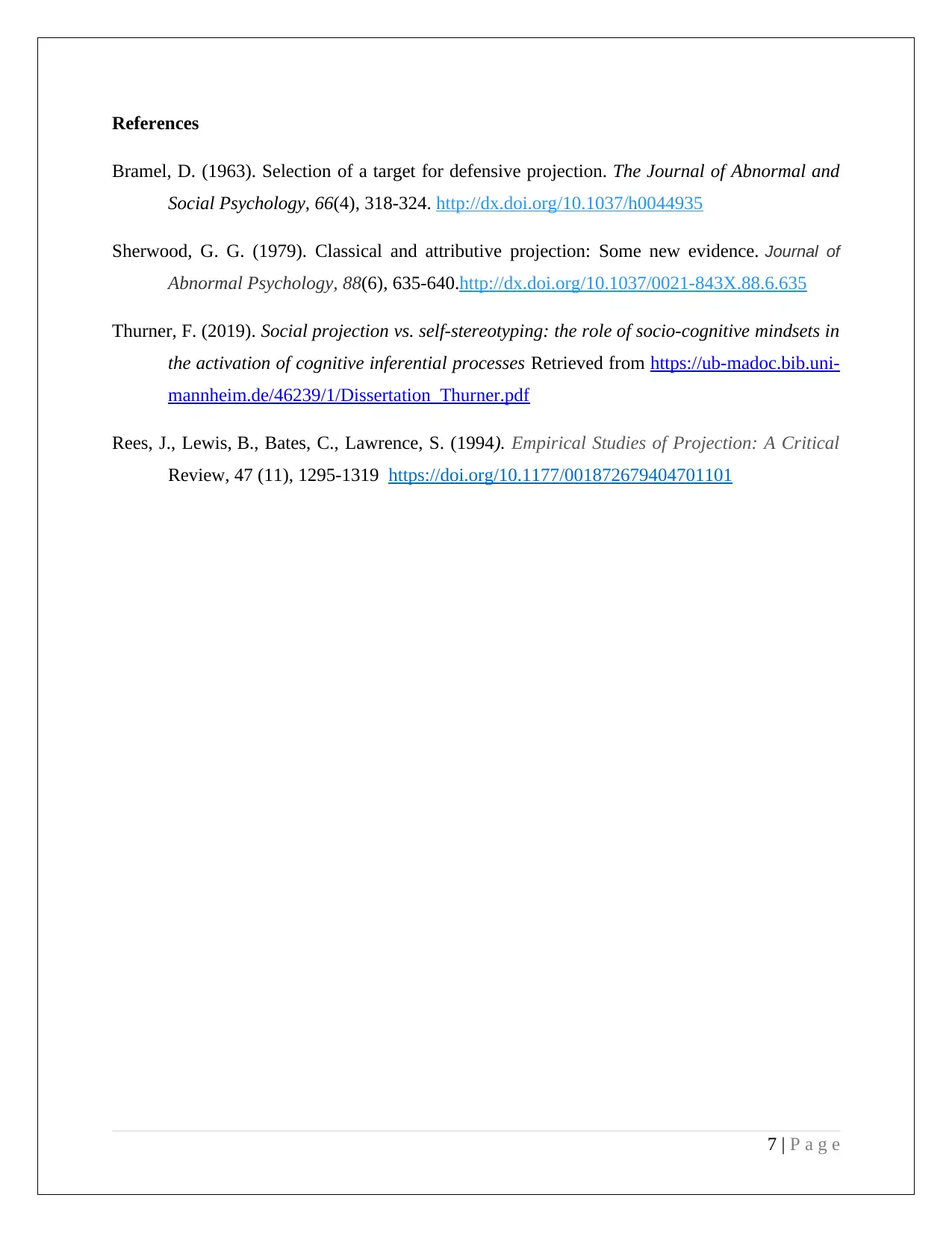
References
Bramel, D. (1963). Selection of a target for defensive projection. The Journal of Abnormal and
Social Psychology, 66(4), 318-324. http://dx.doi.org/10.1037/h0044935
Sherwood, G. G. (1979). Classical and attributive projection: Some new evidence. Journal of
Abnormal Psychology, 88(6), 635-640.http://dx.doi.org/10.1037/0021-843X.88.6.635
Thurner, F. (2019). Social projection vs. self-stereotyping: the role of socio-cognitive mindsets in
the activation of cognitive inferential processes Retrieved from https://ub-madoc.bib.uni-
mannheim.de/46239/1/Dissertation_Thurner.pdf
Rees, J., Lewis, B., Bates, C., Lawrence, S. (1994). Empirical Studies of Projection: A Critical
Review, 47 (11), 1295-1319 https://doi.org/10.1177/001872679404701101
7 | P a g e
Bramel, D. (1963). Selection of a target for defensive projection. The Journal of Abnormal and
Social Psychology, 66(4), 318-324. http://dx.doi.org/10.1037/h0044935
Sherwood, G. G. (1979). Classical and attributive projection: Some new evidence. Journal of
Abnormal Psychology, 88(6), 635-640.http://dx.doi.org/10.1037/0021-843X.88.6.635
Thurner, F. (2019). Social projection vs. self-stereotyping: the role of socio-cognitive mindsets in
the activation of cognitive inferential processes Retrieved from https://ub-madoc.bib.uni-
mannheim.de/46239/1/Dissertation_Thurner.pdf
Rees, J., Lewis, B., Bates, C., Lawrence, S. (1994). Empirical Studies of Projection: A Critical
Review, 47 (11), 1295-1319 https://doi.org/10.1177/001872679404701101
7 | P a g e
1 out of 7
Your All-in-One AI-Powered Toolkit for Academic Success.
+13062052269
info@desklib.com
Available 24*7 on WhatsApp / Email
![[object Object]](/_next/static/media/star-bottom.7253800d.svg)
Unlock your academic potential
Copyright © 2020–2025 A2Z Services. All Rights Reserved. Developed and managed by ZUCOL.